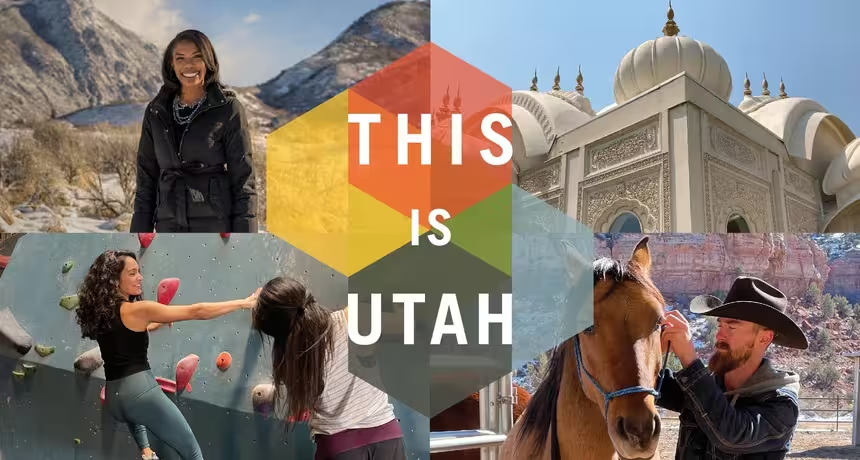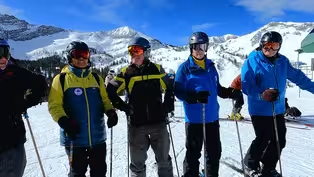
James Fain – Rodeo Photographer
Clip: Season 4 Episode 1 | 7m 20sVideo has Closed Captions
Learn about the photographer from Utah who has been documenting rodeo for over 60 years.
From small towns to the capital city, rodeo is part of Utah's culture and history. Frame by frame, Utah's most prolific rodeo photographer, James Fain, has been documenting that history for over 60 years. He took his last professional rodeo photos in August of 2022 and was recognized for his work by the Professional Rodeo Cowboys Association for his important contribution.
Problems playing video? | Closed Captioning Feedback
Problems playing video? | Closed Captioning Feedback
This Is Utah is a local public television program presented by PBS Utah
Funding for This Is Utah is provided by the Willard L. Eccles Foundation and the Lawrence T. & Janet T. Dee Foundation, and the contributing members of PBS Utah.

James Fain – Rodeo Photographer
Clip: Season 4 Episode 1 | 7m 20sVideo has Closed Captions
From small towns to the capital city, rodeo is part of Utah's culture and history. Frame by frame, Utah's most prolific rodeo photographer, James Fain, has been documenting that history for over 60 years. He took his last professional rodeo photos in August of 2022 and was recognized for his work by the Professional Rodeo Cowboys Association for his important contribution.
Problems playing video? | Closed Captioning Feedback
How to Watch This Is Utah
This Is Utah is available to stream on pbs.org and the free PBS App, available on iPhone, Apple TV, Android TV, Android smartphones, Amazon Fire TV, Amazon Fire Tablet, Roku, Samsung Smart TV, and Vizio.

This is Utah
Liz Adeola travels across the state discovering new and unique experiences, landmarks, cultures, and people. We are traveling around the state to tell YOUR stories. Who knows, we might be in your community next!Providing Support for PBS.org
Learn Moreabout PBS online sponsorship- From small towns to the Capitol City, rodeo is a part of Utah's culture and history, a history that's been captured frame by frame by Utah's most prolific rodeo photographer.
(country western music) - We never really planned on making a career out of photographing rodeo.
It just evolved.
But I don't think of it as a career.
It's just something that happened (laughing).
I had just a common box camera.
I'd snap a few pictures around just for the heck of it.
And finally I bought a little camera that was like a 35 millimeter only it took just a hair larger frame.
The photos that I took with it, I did get published in "Radio Sports News" back in '61.
That was the start of it.
(country western music) I'm kind of spontaneous about a lot of things.
That's the way I shoot rodeo.
I mean, I shoot it as it happens.
(harmonica buzzing) - Oh, Jim, he's a cowboy.
He rodeoed, he rode bulls, loves the sport of rodeo and everybody loves Jim.
Everybody knows Jim.
We are a five generation rodeo outfit.
Jim has pictures of when dad was a young man and when grandpa was a young man and grandpa and grandma and us kids.
You know, pictures of me when I was packing the flag and riding and we got pictures of Jeff when he was riding bulls in high school and then my kids.
I got pictures of my daughter that Jim took when she was running barrels in high school and my son when he was team roping in high school and- - And I think every rodeo family in the Western United States has got the same story to tell.
(harmonica buzzing) - We lose so much of our history just because nobody thinks about it.
In Fain's case, he's everywhere.
Whether it's high school rodeo, whether it's college, whether it's PRCA, he's been on national covers for rodeo magazines all over the world.
- I look at it as trying to show the contestant in championship form and an eight second ride, if it's a good jump kick and the rider's doing good, I can get 10 good shots.
But back shooting film, I could generally tell whether I had a poor shot.
If I don't get a good photograph now on a good ride, I beat myself up over it.
- Most of us don't have the qualifications or the eye to know, well, was that a good ride or was that a bad ride?
I could go out and take the same picture at the same time and it would not look nearly as good as what he does.
He seems to be able to show such energy in the picture.
Jim has that talent of knowing the right moment to catch that picture in time.
It's a time capsule and for our little museum as we call it, he'll bring in and switch off pictures.
Something that he's had old or new or whatever it is.
And that to me is sharing with the public what it is he does.
(country western music) - I've shot a lot of stuff that people have never looked at.
I guess that's kind of the rodeo way too.
It's like you enter the rodeo, the stock's drawn for you, you nod your head and your talent's supposed to carry you through to win some money.
Photographing rodeo is kind of like that really.
You're dependent on your talent to deliver a product that the cowboy wants to buy.
Oh, it's totally on speculation, yeah.
It means you're not making any money (laughing).
(country western music) There's been so many images through the years that never seen the light of day that I wish people had.
I'd give it to them, it's such a good shot.
(country western music) I grew up in Phoenix.
A friend in grade school and he talked me into entering my first rodeo and I was a little over 12 but got on my first calf, fell off and it hurt (laughing).
Then I was hooked.
Went through a year at Arizona State.
In the meantime, I had gotten a job with the Park Service at Grand Canyon.
Yeah, what nicer place could you live than the North Rim of the Grand Canyon in the summertime.
(country western music) Working at the North Rim, Karen and I met.
She talked me into coming up to Utah State which wasn't hard to do (laughing), and Karen made her mind up early on that she was gonna go with me.
We didn't actually come to a verbal agreement.
We just, like I said, things just evolved.
It's a partnership.
You can't do it by yourself.
You're out there photographing so you can't be back here showing your proofs.
- I think she would be like the librarian when you go to get a picture from Jim, the librarian can take you to the right, you know, aisle, the right shelf, and pull that picture because she has recorded everything.
(country western music) - And I'm getting some gratification from these people that are contacting me now looking for images 30 years ago, 40 years ago.
Back then they didn't have any money (laughing).
These people that are, hey, this guy's got pictures that we can get still.
So they're interested.
(country western music) - I have a picture of Wendy, a bowing horse, at the Days of '47, during the opening.
This one that drew me to her right there.
That's a great photo.
- He noticed me then.
- And just before, he was great at this too.
Just before I got knocked out, he took a great photo of me on a bull at the high school finals and so yeah.
- Before he did the dead chicken.
- Before I was rendered unconscious.
Let's just leave it there.
- When you look at that, you remember that moment.
You remember when you was getting ready to come into the arena and you get butterflies and you feel like you're gonna have to hold your breath because, you know, you're nervous.
(country western music) Those pictures capture all those moments.
(country western music) (cymbal clanging) (guitar strumming)
Traveling Through Time | Preview
Preview: S4 Ep1 | 30s | Utah has a rich history of learning and growth, join us as we roam through Utah’s past. (30s)
Video has Closed Captions
Clip: S4 Ep1 | 7m 50s | Follow the Utah Black History Museum that shares the history of Utah’s Black community. (7m 50s)
Wild Old Bunch: The Original Skiing Posse
Video has Closed Captions
Clip: S4 Ep1 | 6m 23s | Learn about the history of the Wild Old Bunch as they hit the slopes of Alta Ski Area. (6m 23s)
Providing Support for PBS.org
Learn Moreabout PBS online sponsorshipSupport for PBS provided by:
This Is Utah is a local public television program presented by PBS Utah
Funding for This Is Utah is provided by the Willard L. Eccles Foundation and the Lawrence T. & Janet T. Dee Foundation, and the contributing members of PBS Utah.


















